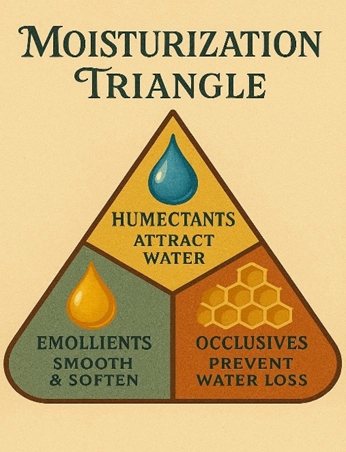Moisturization: Three Keys Unlock the Treasure of Ponce de Léon
- Teutonblade

- May 11
- 2 min read
When it comes to skin care, moisturization is foundational. It preserves the elasticity of the skin, supports enzymatic repair, maintains smoothness, reduces inflammation, and in sum, slows visible aging. In Japan they call it Wakagaeri no Izumi. In Greece, Kanathos. In China, the Jade Pool. Ponce de Léon called it the Fountain of Youth.

Shave soaps and splashes are all about scent and performance. While scent can be assessed by smell, performance is more difficult to measure. Performance has two sides, function and feel. What does it do? How does it make you feel? And it’s different for shave soaps and splashes.
But one goal they share is moisturization, an important benefit and key component of the vaunted post-shave feel. Over decades of dermatological development beginning in the 1940s, three classes of moisturizing ingredients have been identified and combined into what’s become known as The Moisturization Triangle: Humectants, Emollients, and Occlusives.

Humectants attract water and bind it, emollients fill micro-gaps in the skin and soften it, and occlusives form a seal and lock it in. The result is hydration.
The core constituents of any soap are fat and lie, usually tallow, stearic acid, palmitic acid, myristic acid, and potassium hydroxide. Aftershaves are primarily built around alcohol, water, and astringents, usually Witch Hazel. Upon inspection, the remaining ingredients are usually members of the Moisturization Triangle, many of which are natural, some of which are synthesized. Here are the most common and the effect they have on the skin:
Table 1: Common Shave Soap & Splash Additives

When looking at the ingredient list of a shave soap, by identifying the elements of the Moisturization Triangle the degree of moisturization can be assessed. Below are some examples of well known soaps with the ingredients broken down by moisturization elements. Glycerin, which is a natural by-product of saponification, is the most common humectant, butters and oils are the most common emollients, and lanolin is the most common occlusive. Only a select few soaps, in this example Stirling, Gentleman’s Nod, and Mike’s Natural Soaps, employ all three.
Table 2: Popular Shave Soaps - Moisturization Triangle

Aftershaves are limited in which ingredients can be used because they are liquid. Glycerin, a natural liquid, is the most common humectant, while emollients lean towards oils and synthetic ingredients, and occlusives tend to use Dimethicone. In the examples below, only Gentleman’s Nod and Castle Forbes include all three.
Table 3: Popular Aftershaves - Moisturization Triangle

The most cited and highly prized quality of the post-shave feel is to be “well-moisturized”. When considering an aftershave or shave soap one way to predict the post-shave outcome is to inspect the ingredients and look for elements of the Moisturization Triangle. As listed at the bottom of Table 1, other ingredients can also provide benefits and enhance the post-shave feel such as Fuller’s Earth, Kaolin Clay, Tussah Silk, and of course, the king of astringents, Witch Hazel. Not only is Witch Hazel a toner, but it has anti-inflammatory, antioxidant, and anti-microbial properties, a topic worthy of its own in-depth discussion to follow.










This was an extremely well written and researched article. This information will certainly help in making future software choices.
Helpful article. Thanks!